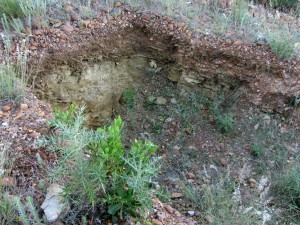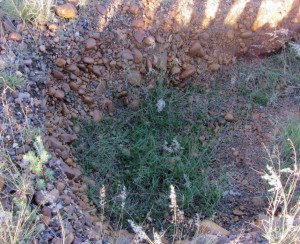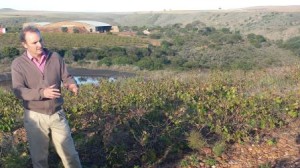Sijnn – the opening of a new cellar in a new area
Tuesday, May 13th, 2014
In today’s crowded wine world, being a winemaker is challenging enough but there are creative people out there for whom the real challenge lies in the unknown. For David and Rita Trafford the unknown lay in 125 ha of stony soil close to the mouth of the Breede River at a place called Malgas. It was an area devoid of vines until they purchased the farm they named Sijnn (pronounced ‘sane’ and the original Khoisan name for the Breede River) and started planting the current 16 ha of vines in 2003.
It was a chance find; back in 2000, the Traffords were spending ‘a weekend away from the kids at a B&B near Malgas. The weather being poor, they took the opportunity to drive around; during their drive, Trafford noticed a ploughed field with pudding stones, a feature which reminded him of Chateauneuf-du-Pape but of nothing he’d ever seen in South Africa. Their interest sparked, the Traffords contacted an estate agent for prices of plots, only to discover this particular one was for sale as the owners were divorcing.
The river at Malgas is still tidal, so salty water could have proved a problem, but Trafford’s concerns were put to rest when he realised gardens belonging to the holiday houses along the banks were growing well. Irrigation of the vineyards is anyway minimal.
Once two partners were brought on board – Simon Farr, from the UK and the founder of Bibendum Wines, and South African businessman Quentin Hurt – the backbreaking task of breaking up the soil, a mix of those pudding stones and fractured Bokkeveld shale, and making holes for the vines began.


Vine selection is of eclectic Mediterranean varieties, associated with several areas and countries: Chenin Blanc, Viognier and Roussanne for whites; Syrah, Mourvèdre, Touriga Nacional, Trincadeira and Cabernet for reds. Beyond the current 16 ha of vineyard, a further 44 ha is suitable for vines; future plans include planting Tempranillo, Nebbiolo and Grenache. The rest of the farm is left to indigenous fynbos and renosterveld vegetation. Aesethically, the all-bush vine vineyards look in pleasing harmony with the indigenous vegetation; the canes appear to fall in happy abandon, in line with other growth. But Trafford explains this method was deliberate “as the way they grow makes a perfect canopy, creating natural balance to allow enough light into the vine”. He adds that trained on a trellis, with the required tipping of the shoots, side shoots would grow and provide too dense a canopy.
Irrigation required is minimal – those seemingly dense pudding stones actually retain 10% on which the roots feed – but also Sijnn lies on the border of the winter and summer rainfall regions, so although the annual average is a meagre 350 mm, it’s fairly evenly distributed throughout the year. Harvest starts later than in Stellenbosch, around mid-March, but the two still coincide.
At the recent opening of Sijnn’s new cellar, David Trafford often had to answer the question ‘Why here?’ “It offered the challenge to do something new; something similar in quality and price to our Stellenbosch winery.” If it was a challenge they were after, the Traffords certainly found the right place. Since the first vintage in 2007 until this year, the wines have been made at their Stellenbosch winery. This involved not only a five-hour drive to deliver the grapes but noteworthy dirt roads at both departure and destination points. Yes, even the Stellenbosch property, the last port of call at the top of the pass between the Helderberg and Stellenboschberg, is approached by a single-lane dirt track.
As we arrived at the cellar, a rental truck was delivering barrels, full ones from the Trafford’s Stellenbosch property. It wasn’t quite the last of the several journeys to bring everything – previously bottled vintages, as well as those still in barrel – back to home base. From now on, Sijnn wines will be grown, made and bottled on the farm. The cellar opening also marked the opportunity for members of the public to visit and buy every Saturday between 10am and 3pm.

The whole project has been designed along eco-friendly lines, with Hurt driving the initiatives. If the vines blend harmoniously with their surroundings, so does the low-tech cellar thanks to architect David Trafford’s sympathetic design and materials – the shale for the mainly dry stone walls formed part of the flood plain that now bears the vines. Since the opening, solar panels have been installed across the cellar roof. “On an average sunny day, these will be able to provide all our power needs for the farm and the winery,” Trafford advises.
How harmoniously the signed tiles, decorated by guests attending the three launch evenings, will blend in with their surroundings in the cellar, remains to be seen. But it’s just the sort of interesting, creative touch the Traffords would introduce.
The range itself has yet to settle into a firm line-up. There are varietal wines, as well as the white and red blends; the Traffords believe winelovers will find varietal wines an easier introduction to Sijnn – a difficult name in itself – as well as the unorthodox blends.
A Platter five-star rating for the Syrah 2011 has projected these elegant wines into the public eye. As they become better known, it’s certain they’ll add to the palette of styles and quality for which South Africa is gaining increasingly positive press.
– Angela Lloyd